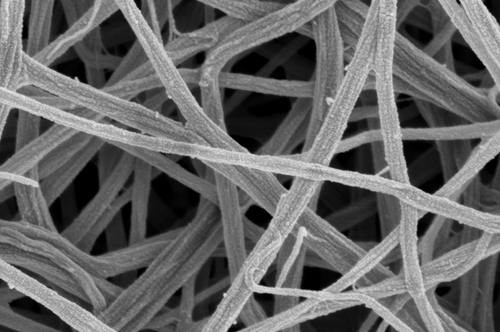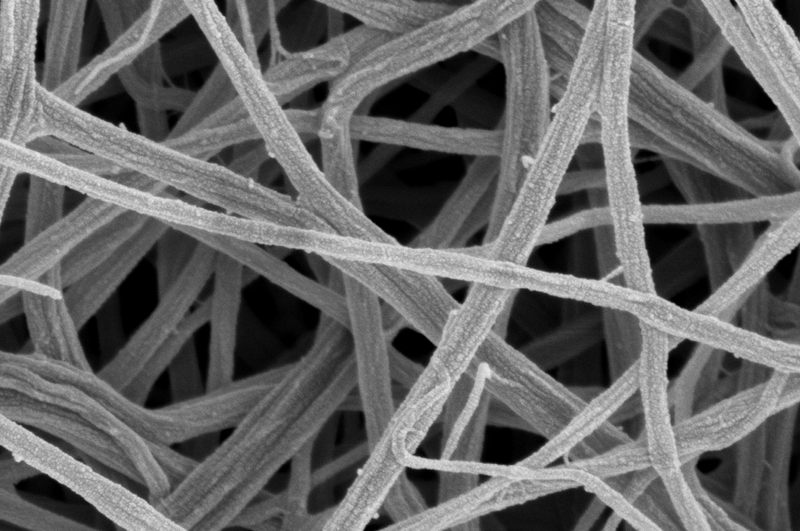Why Some Gels Shrink under Stress
If you push on a block of rubbery material so that its top and bottom surfaces move sideways in opposite directions, it usually bulges out vertically, at right angles to the applied force. However, some composite materials, such as a biopolymer involved in blood clotting, were recently found to do the opposite, contracting instead of expanding. Researchers now offer a simple explanation for this behavior, showing that it arises from the flow of water through the material's microscopic polymer network. The results may be helpful in designing biomaterials with desirable mechanical as well as biomedical properties.
Imagine a block of gelatin fixed between a pair of horizontal plates. Sliding the plates horizontally in opposite directions distorts the material and causes it to push upward and downward on the plates in an attempt to maintain a fixed volume. In fact any material that is both elastic (springy) and incompressible (fixed volume) is expected to react this way. Within the last decade, however, a number of research groups have found that certain biopolymer gels—water-filled networks of naturally occurring filamentary substances—contract when subject to such shear forces. For example, the protein fibrin, which forms a tight mesh at the site of a wound as part of the clotting process, has this anomalous property. Researchers would like to explain fibrin’s behavior in order to better understand clotting.
To understand the anomalous behavior, Daniel Bonn of the University of Amsterdam and his colleagues devised a theoretical model that treats the gel as a network of elastic fibers immersed in a viscous, incompressible fluid and conducted experiments to test it. If the pore size—the typical space between fibers—is small, the fluid remains trapped within the fibers by viscous forces, and the structure as a whole acts like a traditional, incompressible elastic solid. But if the pores are larger, the fluid can move through them, allowing the fiber network to adapt to the shear force. In this case, the network shrinks in the direction perpendicular to the shear force by driving out fluid from its pores. The effect is comparable, the researchers say, to the way a wet sponge expels water and shrinks when twisted.
In this model, the response of any given gel is governed by the time scale on which fluid can move, which is determined by pore size and fluid viscosity. To test their analysis, the team made biopolymer gels from fibrin. By controlling the synthesis conditions, they made fibrin gels with pore sizes from 0.08 to 0.36 micrometers, corresponding to time scales for fluid movement of between 100 seconds and a few seconds.
The researchers measured the response to a shear force using a standard device that squeezed the fibrin gel between a flat plate and a rotating cone pressed into the gel. Twisting the cone through some angle and then holding it still generated a shear stress in the gel, and the device measured the vertical-force, up or down, produced in response. The team found that the immediate reaction of fibrin gels to this shear force was either expansion or, in some cases, no detectable force, indicating that on short time scales, they behaved like classical, incompressible elastic solids. In accord with the new theory, however, each gel relaxed into a contracting state over a period of time that depended on its pore size.
A further prediction of the theory is that any gel should relax to a contracting response if given enough time. The researchers examined a synthetic polymer gel with a much smaller pore size, about 10 nanometers. After applying a shear force, they waited 15 hours and finally observed the gel behavior changing from expansion to contraction.
The results may help researchers better understand the biomechanical aspects of blood clotting and other functions, says Bonn. He says that the team’s findings may also be useful in the design of mechanical systems, such as shock absorbers, whose response changes on a chosen time scale. Ellen Arruda of the University of Michigan in Ann Arbor says she is “intrigued by the implications for gel applications, such as the design of scaffolds for tissue engineering.” In such cases, she explains, the pore size must be optimized for biological reasons, such as cell infiltration of a biomaterial, so the new theory will help in tuning the properties of a material to balance its biological and mechanical characteristics.
This research is published in Physical Review Letters.
–David Lindley
David Lindley is a freelance science writer in Alexandria, Virginia.





